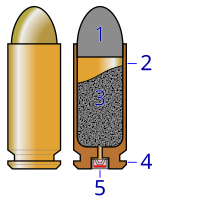
Photo from wikipedia
In this work, distinct but related targets were studied using a circular synthetic aperture sonar system. Backscattering data from a solid brass cylinder were recorded. The response of the target… Click to show full abstract
In this work, distinct but related targets were studied using a circular synthetic aperture sonar system. Backscattering data from a solid brass cylinder were recorded. The response of the target was significantly spread out in time because leaky guided waves were weakly radiation damped. They gave significant backscattering contributions for a range of tilt angles. The associated meridional and helical wave contributions are also obvious in the frequency domain. (For comparison helical contributions are relatively weak for aluminum cylinders.) The second target is a bi-metallic cylinder made of a 1:1 brass cylinder bonded to a 3:1 aluminum cylinder. For a single-material cylinder, only 90 degrees of data are necessary due to symmetry. This target breaks that symmetry and requires a full 180 degrees of rotation. The distinction between the brass and aluminum ends is discernible in both the time and frequency domain. The join between the two metals affects the timing of certain guided waves that no longer travel the whole length of the compound cylinder. Image reconstruction was performed using Fourier based algorithms for both targets. The location of the compound cylinder joint is deducible from the location of features in the image domain. [Research supported by ONR.]In this work, distinct but related targets were studied using a circular synthetic aperture sonar system. Backscattering data from a solid brass cylinder were recorded. The response of the target was significantly spread out in time because leaky guided waves were weakly radiation damped. They gave significant backscattering contributions for a range of tilt angles. The associated meridional and helical wave contributions are also obvious in the frequency domain. (For comparison helical contributions are relatively weak for aluminum cylinders.) The second target is a bi-metallic cylinder made of a 1:1 brass cylinder bonded to a 3:1 aluminum cylinder. For a single-material cylinder, only 90 degrees of data are necessary due to symmetry. This target breaks that symmetry and requires a full 180 degrees of rotation. The distinction between the brass and aluminum ends is discernible in both the time and frequency domain. The join between the two metals affects the timing of certain guided waves that no longer ...
Journal Title: Journal of the Acoustical Society of America
Year Published: 2018
Link to full text (if available)
Share on Social Media: Sign Up to like & get
recommendations!